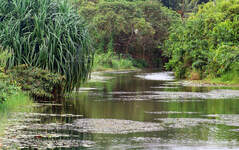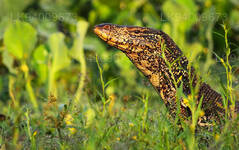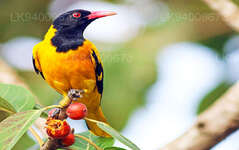
Miasto Kolombo
Kolombo, stolica Sri Lanki, to dynamiczne miasto łączące tradycję z nowoczesnością. Zachwyca kolonialną architekturą, tętniącymi życiem targowiskami i spokojnymi świątyniami buddyjskimi. Z różnorodną kuchnią, rozległą panoramą i pięknymi plażami, stanowi tętniące życiem centrum biznesu, kultury i turystyki, oferując bramę do odkrywania cudów Sri Lanki.
Talangama Wetland
The Thalangama Wetlands are the swamps surrounding the lake, which is located in the Thalangama area of Battaramulla. It’s quite shocking to realize that this haven of nature lies less than an hour outside the busy commercial center of Colombo.
What is a Wetland?
The Ramsar Convention (an international treaty for the conservation and suitable utilization of wetlands) defines the word wetland as ‘areas of marsh, fen, peatland or water, whether natural or artificial, permanent or temporary, with water that is static or flowing, fresh, brackish or salt, including areas of marine water the depth of which at low tide does not exceed six meters’. Wetlands can help in the mitigation of floods, offer protection from storms, help in the retention of sediment, act as a carbon sink, and be an excellent purifier of water.
About the Thalangama Wetlands
The Thalangama lake itself was manmade several centuries ago for irrigation purposes, and is surrounded by numerous paddy fields, canal, ponds and marshes. It supports a rich ecosystem that hosts thousands of species of exotic flora, over a hundred different species of birds, several species of butterflies and dragonflies, a few species of damselflies, reptiles and amphibians, and some small mammals. Given below is a list of confirmed sightings in some of the categories.
Birds
- Purple Swamphen
- White-breasted Waterhen
- Common Moorhen
- Pheasant-tailed Jacana
- Little Grebe
- Little Cormorant
- Cattle Egret
- Little Egret
- Intermediate Egret
- Oriental Darter
- Purple Heron
- Grey Heron
- Little Green Heron (Striated Heron)
- Indian Pond Heron
- Black-crowned Night- Heron
- Little Heron
- Oriental Honey-buzzard
- Red-wattled Lapwing
- Black Bittern
- Yellow Bittern
- Asian Open-bill
- Painted Stork
- Black-headed Ibis
- Glossy Ibis
- Lesser Whistling Teal
- Cotton Pigmy Goose
- Pied Kingfisher
- Common Kingfisher
- White-Throated Kingfisher
- Stork-billed Kingfisher
- Common Sandpiper
- Kentish Plover
- Lesser Sand Plover
- Golden Plover
- Marsh Sandpiper
- Common Redshank
- Common Greenshank
- Wood Sandpiper
- Curlew Sandpiper
- Black-winged Stilt
- Little Stint
- Imperial Green Pigeon
- Emerald Dove
- Spotted Dove
- Greater Coucal
- Rose-ringed Parakeet
- Asian Koel
- Indian Scops-owl
- Collared Scops-owl
- Brown Hawk-owl
- Little Green Bee-eater
- Ceylon Small Barbet
- Indian Pigmy Woodpecker
- Lesser Yellownape
- Black-rumped Flameback
- White-browed Bulbul
- Indian Pitta
- Barn Swallow
- Forest Wagtails
- Yellow Wagtails.
- Pintailed Snipe
- Kora (Watercock)
- Blue-tailed Bee-eaters
- White-backed Munia
- Dark-fronted Babblers
- Black-headed Munia
- Asian Paradise-Flycatcher
- Indian Swiftlets
- Little Swift
- Shikra
- Serpent Eagle
- Honey-buzzard
- Brown Shrike
- Black-headed Cuckooshrike
- Ceylon Green-Pigeon
- Petrel
- Pelican
- Black-hooded Oriole
- Yellow-billed Babbler
Dragonflies
- Blue-eyed Pondcruiser (Epophthalmia vittata)
- Rapacious Flangetails (Ictinogomphus rapax)
- Sombre Lieutenants (Brachydiplax sobrina)
- Spine-legged Redbolts (Rhodothemis rufa)
- Scarlet Baskers (Urothemis signata)
- Green Skimmer (Orthetrum sabina)
- Blue Pursuer (Potamarcha cogener)
- Elusive Adjutant (Aethrimanta brevipennis)
- Yellow Waxtail (Ceriagrion coromandelianum)
- Painted Waxtail (Ceriagrion cerinorubellum)
- Sapphire Flutterer (Rhyothemis triangularis)
Reptiles, Amphibians and Mammals
- Water Monitor
- Purple-faced Leaf Monkey
- Indian Porcupine
- Brown Mongoose,
- Palm Civet Cat
- Fishing Cat
- Otter
- Moose Deer
Things to do at the Thalangama Wetlands:
- Birdwatching ( Start early in the day. Bring your binoculars and cameras. Average sightings for a Half-Day Birdwatching Tour – 60 to 70 species )
- Butterfly/Dragon Fly Watching
- Nature Tour
- Jogging
- Cycling
While enjoying the nature make sure that you take only photos and memories, and leave only your footsteps. Protect the ecology for the future.
O dystrykcie Kolombo
Kolombo to największe miasto i stolica handlowa Sri Lanki. Położone jest na zachodnim wybrzeżu wyspy, w sąsiedztwie Sri Jayewardenepura Kotte, stolicy Sri Lanki. Kolombo to tętniące życiem i pełne życia miasto, łączące w sobie nowoczesny styl życia z kolonialnymi budynkami i ruinami. Liczba mieszkańców wynosi 647 100. Region Metropolitalny Kolombo, definiowany przez dystrykty Kolombo, Gampaha i Kalutara, liczy około 5 648 000 mieszkańców i zajmuje powierzchnię 3694,20 km². Kolombo to miasto wieloetniczne i wielokulturowe. Jest to najludniejsze miasto na Sri Lance, z 642 163 mieszkańcami mieszkającymi w granicach miasta. Populacja Kolombo to mieszanka licznych grup etnicznych, głównie Syngalezów, Maurów i Tamilów. W mieście mieszkają również niewielkie społeczności osób pochodzenia chińskiego, portugalskiego, holenderskiego, malajskiego i indyjskiego, a także liczni europejscy emigranci. Zdecydowana większość lankijskich korporacji ma swoje siedziby w Kolombo. Wśród branż znajdują się m.in. przemysł chemiczny, tekstylny, szklarski, cementowy, skórzany, meblarski i jubilerski. W centrum miasta znajduje się drugi co do wysokości budynek w Azji Południowej – World Trade Center.
O dystrykcie Kolombo
Prowincja Zachodnia jest najgęściej zaludnioną prowincją Sri Lanki. Znajduje się tu stolica parlamentarna Sri Dźajawardanapura Kotte, a także Kolombo, centrum administracyjne i biznesowe kraju. Prowincja Zachodnia dzieli się na trzy główne dystrykty: Kolombo (642 km²), Gampaha (1386,6 km²) i Kalutara (1606 km²). Jako centrum gospodarcze Sri Lanki, w mieście obecne są wszystkie główne lokalne i międzynarodowe korporacje, a także wszyscy najwięksi projektanci i detaliści, dlatego warto przygotować się na zakupy w prowincji Zachodniej. Z uwagi na największą liczbę ludności w całej prowincji, w prowincji Zachodniej znajdują się niemal wszystkie najważniejsze instytucje edukacyjne na wyspie. Do uniwersytetów w prowincji zaliczają się: Uniwersytet Kolombo, Uniwersytet Sri Jayewardenepura, Uniwersytet Kelaniya, Otwarty Uniwersytet Sri Lanki, Uniwersytet Buddyjski i Palijski Sri Lanki, Uniwersytet Obrony Generała Sir Johna Kotelawali i Uniwersytet Moratuwa. W prowincji zachodniej znajduje się najwięcej szkół w kraju, w tym szkoły państwowe, prowincjonalne, prywatne i międzynarodowe.










































